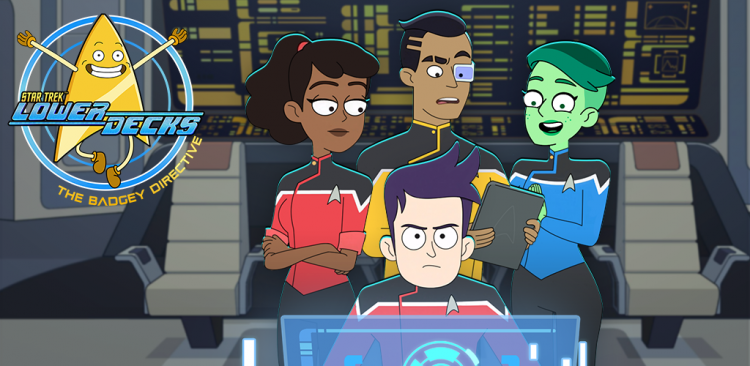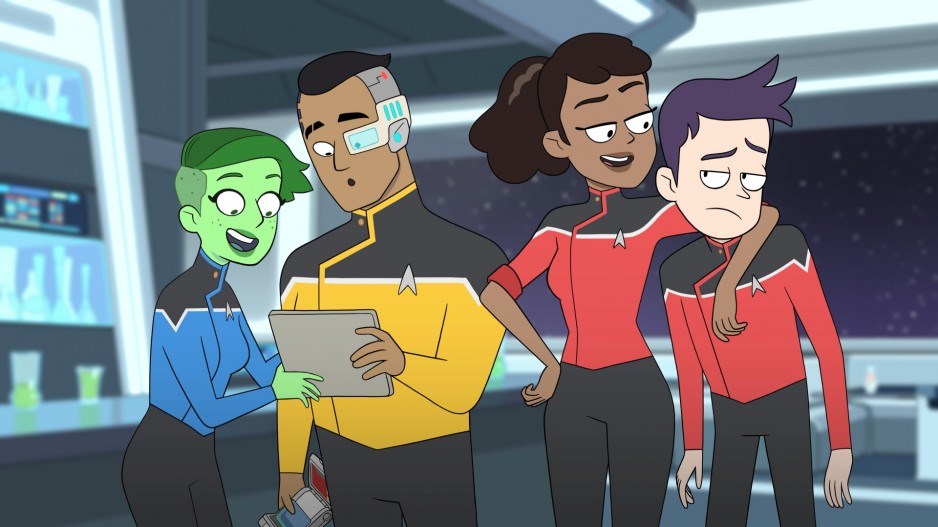“Welcome, captain,” the commander of the USS Vancouver says to her USS Cerritos counterpart in a Season 1 episode of the animated comedy series Star Trek: Lower Decks.
“Take it in. One day you could be in command of a vessel like the Vancouver.”
The top-of-the-line tech and ace crew populating the fictional Vancouver starship leaves a distinct impression over the course of the adventure it might just be a cut above the Cerritos, the show’s main setting.
“When we had a visit from the Vancouver in an episode, we wanted it to feel almost the same but slightly better,” said Barry J. Kelly, one of the show’s Los Angeles-based directors.
The Parliament-class starship is a little bigger and the colours pop a little more compared with the California-class Cerritos.
Plus, poutine is always on the menu, added animation director Bel Oh of Titmouse Animation Canada Inc., who also worked on the episode that paid homage to the city where the show is produced.
In a universe sprinkled with many strange new worlds, the 56-year-old franchise has recently taken to a new corner of the galaxy within B.C.’s creative tech and film industries by partnering with Titmouse and others local firms ranging from gaming to visual effects (VFX).
California had served as the home base for Star Trek series since 1966. But in 2015 the most recent film starring Chris Pine was filmed in Vancouver, where Oscar-winning visual effects house Double Negative Ltd. (DNEG) served as the primary VFX partner for the US$185 million blockbuster. The Vancouver DNEG studio has since gone on to win Oscars for sci-fi adventures Bladerunner 2049 and Dune, as well as Neil Armstrong biopic First Man, which also took place in outer space for extended periods.
When the Star Trek franchise ventured into animated comedy for the first time, Titmouse’s Hollywood office quickly began collaborating with its Canadian counterparts ahead of the 2020 premiere.
Oh’s team is responsible for taking the storyboards delivered from L.A. – the blueprints of an episode, as she calls them – and actualizing everything from the movements to the colours as they appear once the show airs.
Texture and lightning, which many viewers might not notice unless those elements are missing, are also brought to life for visits to the home world of the IQ-deficient Pakleds or encounters with the horned Mugato beasts.
The third season premieres this summer, and the show is now spinning off its first mobile game, which is being developed a few blocks from the Titmouse operations in Vancouver’s Mount Pleasant neighbourhood (eagle-eyed Trekkies may have spotted shuttles on the Lower Decks series featuring the names of other neighbourhoods such Kitsilano, Marpole and Fairview).
East Side Games Group Inc. (TSX:EAGR) spent much of the last decade cutting its teeth developing titles born from existing intellectual property such as The Trailer Park Boys, Cheech & Chong and The Office.
It was only natural, then, that the Vancouver-based developer would make a warp-speed jump into Star Trek universe, according to co-founder and general manager Josh Nilson.
“We try to make sure that the game has enough nuances in it that it’s for the hard-core fans. So they’ll see Easter eggs in the game, and they’ll see plot lines and we’ll talk about characters,” he said about the The Badgey Directive game based on Lower Decks.
“And then for the real casual fans that know Star Trek, but maybe they’ve only watched a couple episodes of Lower Decks … we want to bring them into the series because we really think if you play games, go back and watch the series, maybe follow the social media accounts, we can really be additive.”

East Side Games is co-developing the title with Australia’s Mighty Kingdom Pty Ltd. in an arrangement that sees the pair working together to ensure the game’s narrative feels natural as the main characters – the low-level officers occupying the “lower decks” of the Cerritos – try to outmanoeuvre a deranged computer program.
While the Vancouver company handles the product side to ensure the gameplay flows smoothly, the Mighty Kingdom team handles the artwork.
The game is expected to be released later this year in the U.S., but Canadian Trekkies can already play it as part of a soft launch.
“We’re able to tap into this big fan base and work on a [co-development] relationship, working closely with CBS just to make sure that we get the tone,” Nilson said, referring to the American studio behind the TV arm of the franchise.
The tone of Lower Decks is also distinct within a franchise known for its serious examinations of terrorism, addiction, class and gender.
The animated series is more prone to playing transporter room malfunctions for laughs rather than the typically more serious existential studies into what the inadvertent creation of a doppelganger might mean for one’s individuality.
The pandemic has also fundamentally changed how game development and animation operates now, with both Eastside Games and Titmouse relying on Vancouver teams who work from home.
“Now there’s no difference between L.A. and Vancouver, it almost feels like,” said Oh, adding that the emergence of remote working in the animation industry has opened the door to working with more overseas freelance artists than any other project she’s worked on.
The Vancouver team still remains the biggest contingent animating the series, and Titmouse Canada vice-president Kramer Hoehn, who heads production, said between 350 and 400 people could be working on any given project.
“But again, right now, there are very few people in studio,” he told BIV, adding the animation industry was incredibly lucky to have been able to tap the technology necessary to keep production flowing during the pandemic.
“There was a little blip, but we haven’t really missed a beat.”
On the other side of the country, two live-action Star Trek series filming in Toronto have had to navigate COVID-19 protocols that have kept actors at a distance from each other on set or else isolated at home for days if a positive test emerges.
“I’m not sure the other Star Trek live action shows can say that they were able to deliver on time in the pandemic,” said Kelly.
“We were lucky that we could just keep trucking along.”




